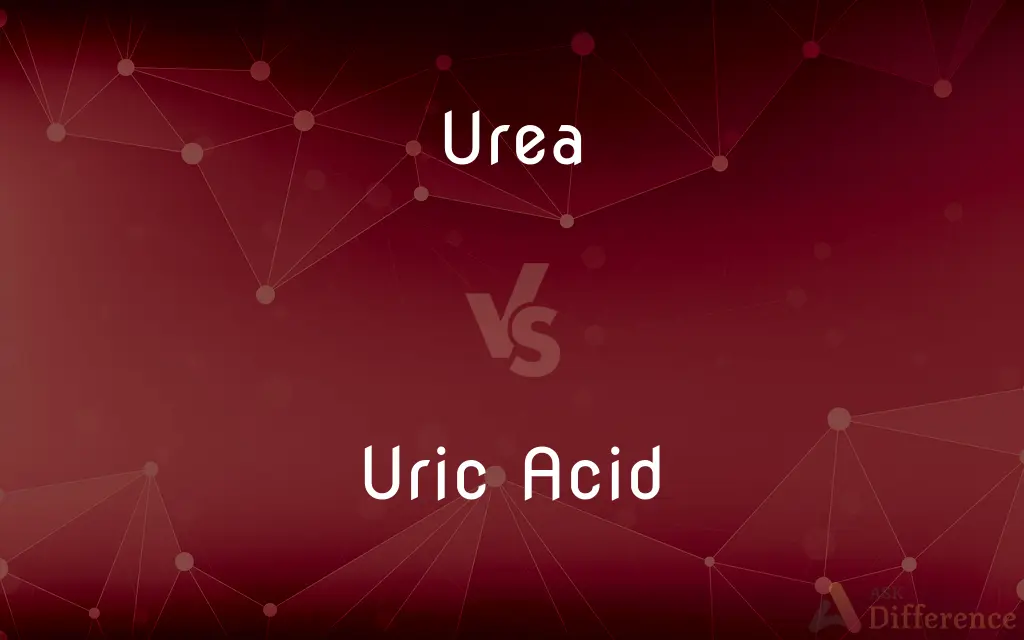Urea vs. Uric Acid — What's the Difference?
By Tayyaba Rehman — Published on January 6, 2024
Urea is a major nitrogenous waste in mammals, excreted in urine. Uric acid is a waste product formed from purine breakdown, primarily excreted by birds and reptiles.

Difference Between Urea and Uric Acid
Table of Contents
ADVERTISEMENT
Key Differences
Urea is an organic compound formed in the liver as the end product of protein metabolism and is excreted by the kidneys in mammals. It is the primary vehicle for removing nitrogenous waste from the body. Uric acid, on the other hand, is a byproduct of purine nucleotide metabolism and is excreted mainly by birds, reptiles, and insects. In humans, it's excreted to a lesser extent compared to urea.
Chemically, urea is a small, water-soluble molecule with a relatively simple structure, comprising two amine groups attached to a carbonyl group. Uric acid is a larger, more complex molecule and less soluble in water, which contributes to its tendency to form crystals in certain conditions, like gout in humans.
In terms of excretion, urea is dissolved in water and excreted in urine, making mammalian urine a fairly liquid substance. In contrast, uric acid is excreted as a paste or powder in birds and reptiles, conserving water – a crucial adaptation for these species.
Urea's role in the human body is primarily excretory, serving as a means to safely remove nitrogen. Uric acid, while also a waste product, can accumulate in the human body, sometimes leading to medical conditions like gout and kidney stones when present in high concentrations.
In summary, while both urea and uric acid are involved in the excretion of nitrogenous wastes, they differ in their chemical structure, solubility, the method of excretion, and the species in which they are primarily found. Urea is the main form of nitrogenous waste in mammals, while uric acid serves a similar function in birds and reptiles.
ADVERTISEMENT
Comparison Chart
Source of Production
End product of protein metabolism in liver
Byproduct of purine metabolism
Solubility in Water
Highly soluble
Less soluble, forms crystals in certain conditions
Primary Excretory Method
Excreted as a dissolved compound in urine
Excreted as a paste or powder in birds and reptiles
Role in Humans
Main nitrogenous waste, excreted in urine
Excreted to a lesser extent, can cause gout when accumulated
Chemical Structure
Simple structure with two amine groups
Complex structure, less soluble
Compare with Definitions
Urea
Urea is synthesized in the liver.
Urea formation in the liver is a key part of protein digestion.
Uric Acid
Uric acid can accumulate and cause gout in humans.
High levels of uric acid in the blood are associated with gout attacks.
Urea
Urea is the primary nitrogenous waste in mammals.
Mammals excrete nitrogen primarily in the form of urea.
Uric Acid
Uric acid is less soluble in water compared to urea.
The low solubility of uric acid can lead to crystal formation in joints.
Urea
Urea is a nitrogenous waste product of protein metabolism.
Urea is excreted in human urine to remove excess nitrogen.
Uric Acid
Uric acid is a waste product from the breakdown of purines.
Uric acid levels can rise with the consumption of purine-rich foods.
Urea
Urea is highly soluble in water.
The high solubility of urea makes it efficient for renal excretion.
Uric Acid
Uric acid is a larger, more complex molecule than urea.
The complexity of uric acid contributes to its reduced solubility.
Urea
A water-soluble compound, CO(NH2)2, that is the major nitrogenous end product of protein metabolism and is the chief nitrogenous component of the urine in mammals and certain other animals. Also called carbamide.
Uric Acid
Uric acid is primarily excreted by birds and reptiles.
Birds excrete uric acid to conserve water.
Urea
A water-soluble organic compound, CO(NH2)2, formed by the metabolism of proteins and excreted in the urine.
Urea
Any N-substituted derivative of urea, with the general formula (R1R2N)CO(NR3R4).
Urea
A very soluble crystalline body which is the chief constituent of the urine in mammals and some other animals. It is also present in small quantity in blood, serous fluids, lymph, the liver, etc.
Urea
The chief solid component of mammalian urine; synthesized from ammonia and carbon dioxide and used as fertilizer and in animal feed and in plastics
Urea
Urea is a compound with two amine groups connected to a carbonyl group.
The chemical structure of urea allows it to be efficiently processed by the body.
Common Curiosities
Can high levels of urea be harmful?
Yes, high levels of urea can indicate kidney dysfunction.
What dietary changes can affect uric acid levels?
A diet high in purines can increase uric acid levels.
What is uric acid?
Uric acid is a byproduct of purine nucleotide metabolism.
How is uric acid excreted in humans?
In humans, uric acid is excreted through urine.
Is urea soluble in water?
Yes, urea is highly soluble in water.
What are purines?
Purines are nitrogen-containing compounds found in many foods.
What is urea?
Urea is a nitrogenous compound formed in the liver from protein metabolism.
Where is urea produced in the body?
Urea is produced in the liver.
How are urea levels tested?
Urea levels are tested through a blood urea nitrogen (BUN) test.
Why do birds excrete uric acid instead of urea?
Birds excrete uric acid to conserve water.
Can uric acid lead to kidney stones?
Yes, high uric acid levels can contribute to kidney stone formation.
What causes gout in relation to uric acid?
Gout is caused by the accumulation of uric acid crystals in joints.
Can dehydration affect uric acid levels?
Yes, dehydration can concentrate uric acid and increase its levels.
Is urea harmful to the skin?
Generally, urea is safe and is used in skincare products for its hydrating properties.
Is urea used in any commercial products?
Yes, urea is used in cosmetics and fertilizers.
Share Your Discovery

Previous Comparison
RPC vs. RMI
Next Comparison
HDLC vs. PPPAuthor Spotlight
Written by
Tayyaba RehmanTayyaba Rehman is a distinguished writer, currently serving as a primary contributor to askdifference.com. As a researcher in semantics and etymology, Tayyaba's passion for the complexity of languages and their distinctions has found a perfect home on the platform. Tayyaba delves into the intricacies of language, distinguishing between commonly confused words and phrases, thereby providing clarity for readers worldwide.













































